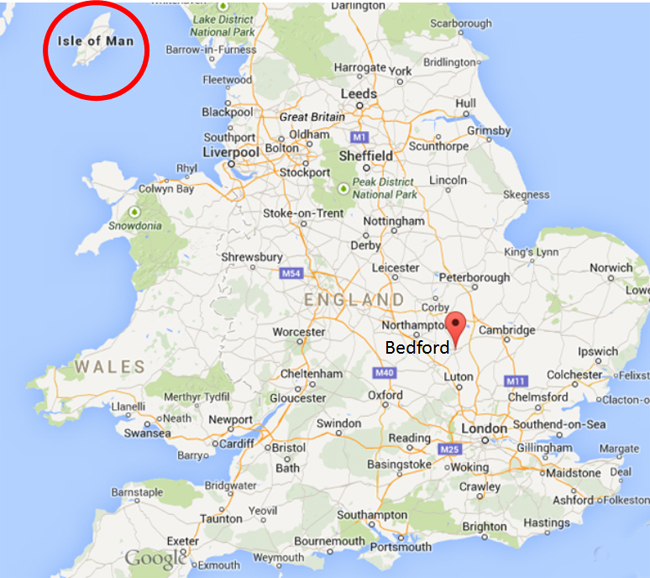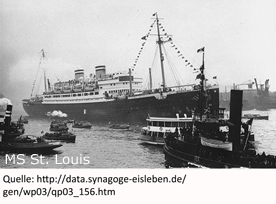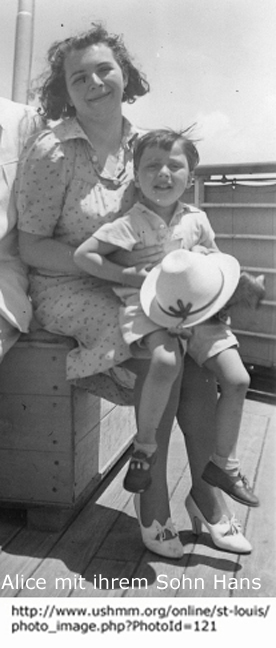 |
 |
 |
 |
 |
 |
 |
 |
The day after Reichskristallnacht Ludwig Eisner fled to Breslau and contacted Edna Cohn in the US. Although she was only very remote relative she provided Kuban visa for himself, his daughter Alice and her family.
On May 13, 1939 they left Germany together with more than 900 refugees on board the St. Louis from Hamburg. The family travelled first class. Rosa Eisner remembered later that the ticket cost 1,500 RM. Two container of the family were also on board full with furniture for their new home. Alice had bought them. Her mother had come over from Guttentag to accompany her. They sew jewelry into the sofa to smuggle it out of Germany. But the two container got lost.
Before Ludwig Eisner was allowed to leave, the Nazi-administration ransacked his confiscated bank account: In the first instance he had to pay 16,000 RM Reichsfluchtsteuer (a capital flight tax), then another 3,900 RM. In addition, he had to pay 11,000 RM Judenvermögensabgabe (Capital levy for Jews). And he had to pay a fine of 8,000 RM because he was in possession of a radio. He not only had to leave behind the furniture of his Guttentag flat but also the furniture he had bought for expatriation. His luggage was taken away from him during the flight, too. Jews who “wanted” to leave Germany were not allowed to take more than 10 RM with them.
The money my grandfather had paid for the Eisner property has never reached the family.
When they arrived in Kuba, they were not allowed to disembark. After demonstrations of the Kuban people against Jewish immigration, the Kuban president revoked the issued immigration visa. Negotiations of several days` duration took place in the harbor of Kuba, targeted at making immigration possible but finally failed.
What Ludwig Eisner didn't know was that his old Guttentag aquaintance Max Lewin, who came to Cuba two month and two ships earlier and knew that Ludwig was on the ship tried to get into contact with him. He charted a boat and tried to get as close as possible to the St. Louis. But the attempt failed.
Subsequently the ship sailed in the direction of the US and cruised along the coast of Florida for several days. Roosevelt intended to permit the immigration but the Democratic Party insisted on full compliance with entry requirements. As Roosevelt was campaigning for reelection, he finally gave in. The St. Louis had to sail back to Germany. Some refugees committed suicide by jumping over board. On the way back, captain Schröder managed to persuade the UK, France, the Netherlands and Belgium to welcome the refugees. When they were teenager Alice and her brother had been presented by her parents with a grand tour through Europe and she liked Paris best. And because she spoke French, she wanted to choose France as immigration country. But as her husband only spoke some English, they opted for England – a lucky decision as most of the refugees that had decided to stay in continental Europe were victimized by the Nazis after the war had broken out and many lost their lives.
Shortly after the arrival in the UK WWII broke out and Ludwig Eisner and his son-in-law were detained at the Ile of Man as “hostile” Germans. Unfortunately it is not possible to find out how long the internment was, but probably not more than some month.
Read here, why research about the internment on the Isle of Man is so difficult.
Together with her son who had been renamed to John, Alice was sent to the English countryside, to Bedford.
Read or hear the interview John Meyerstein gave to the
United States Holocaust Memorial Museum in 2004
in which he told about the MS St. Louis
and also about his family history.


